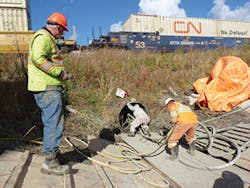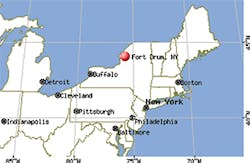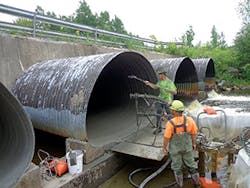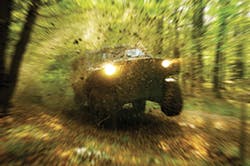Project Profile: Roads, Rivers, and Rail: Structural Culvert Rehabilitation
Failing culverts pose serious hazards to drivers, businesses, and rail traffic. It is incumbent upon design engineers and owner-managers to ensure that structures are sound and reliable. Department of Transportation, county, municipal, and railway maintenance and engineering divisions play a critical role in conducting routine inspections and repairs. Many repairs must be accomplished with zero to minimal impact on businesses, residents, and traffic—whether military, interstate commerce, county and municipal, or rail. And further complicating some repairs is the need for environmental sensitivity—for instance, when fish passages are involved.
This case study features a project requiring heavy-load-rating repairs, without closures to aboveground traffic. It also illustrates precautions implemented to protect a recognized trout stream.
Fort Drum in Jefferson County, NY, is home to the Army’s 10th Mountain Division. Roadways, culverts, and bridges here must support heavy military equipment—tanks are common sights on Fort Drum, as are Mine-Resistant Ambush Protected vehicles (MRAPs), weighing between 14 and 18 tons. Like many municipalities, Fort Drum is faced with aging infrastructure. And being in Upstate New York, near the Canadian border, Fort Drum experiences some of the highest levels of snowfall in the world. This directly translates to the corresponding stresses and strains of freeze-thaw cycles and road-salt damage.
In July 2016, all these factors came together when a 56-foot-wide road-supporting culvert needed rehabilitation. The culvert, laid in a trout stream, consisted of four 142-inch-by-91-inch corrugated metal pipe (CMP) arches laid parallel to one another with a separation of 3 feet between each barrel and only 3 feet of cover over the barrel crowns.
Two other complications applied: the buried bridge is set in the Black River, a recognized trout stream, and the military roadway needed to stay open. So the structure couldn’t simply be torn out and replaced, and river diversions had to be limited and carefully managed.
In any rehabilitation project, critical factors in evaluating solutions include site accessibility, space availability required for equipment associated with repair solution options, activity level of the road or rail line and associated cost or business impact of closure, and temperature considerations relevant to various repair solutions.
Kampbell has been working with both manufacturers and suppliers of various rehabilitation solutions for many years, developing rehabilitation approaches for challenging situations like this. And in this case, specifying and applying a centrifugally cast, fine aggregate composite concrete was an ideal structural solution. The application method and the selected material are both critical to a successful structural rehabilitation.
“Here in Fort Drum, CentriPipe, a solution from AP/M Permaform, was a natural fit,” he says. “CentriPipe is a centrifugally cast concrete pipe technology that uses a spincaster to apply thin layers of concrete to pipe interiors. The spincaster is great in itself because it casts a very smooth and even pipe. And the material used, PL-8000, was just what this project needed—completely structural, and it adheres well to most surfaces, including CMP.”
When specifying centrifugally cast concrete, the material used should have ASTM C1609 testing, exhibit strain hardening, and have a quantifiable amount of toughness and minimal residual stress after initial cracking.
“The sophistication of this fine aggregate concrete should not be taken lightly by the design engineering community,” says Kampbell. “And it’s not just its strength characteristics, which dramatically exceed those of most concrete products. Low permeability, good freeze-thaw characteristics, the right thixotropy and thin shell toughness—AP/M Permaform has really got all these right with PL-8000, and that makes it a great choice for culverts and buried bridges like this one.”
In a technical paper prepared for AP/M Permaform, Kampbell examined some of these properties in detail.
“PL-8000 has the ability to become fluid—i.e., experience a viscosity decrease—when it’s stirred or shaken,” explains Kampbell. “That produces a flowable mixture that can then be pumped long distances. And once it’s cast into position onto the wall of a structure it thickens up quickly, providing sufficient ‘hang-time’ for the wet concrete applied to take its initial set. Getting the thixotropy right is so important—it helps the contractor apply consistent layer thicknesses, it enables good flow into low areas like corrugations and open joints, and it means the initial layers stick well to substrates, providing a dense foundation for the new concrete liner with the host pipe structure.”
“The use of fibers in PL-8000 is one factor that increases the ductility of the hardened liner’s overall [in-place] performance,” says Kampbell. “This gives the rehabilitation outstanding abrasion, impact, and shatter resistance, lengthening the service life of rehabilitated sewers and pipes.” Because the Black River is a trout stream, great care had to be taken with dewatering and diverting the stream. The project also called for a fish ladder to be installed.
To handle diversion efficiently and safely, Arold Construction Company, the regional licensed CentriPipe applicator based in Kingston, NY, decided to work on two culverts at a time—that is, water was diverted from two of the arched CMP culverts and these two were completely rehabilitated before the process was repeated with the final two. Diversion was accomplished with cofferdams and bypass pumping, and diverted water was filtered through large bio bags before being reintroduced to the river. Dewatering also required some CMP repair before lining began.
Many considerations must be accounted for when calculating proper design thickness for centrifugally casting fully structural rehabilitated pipe. These factors include weight load, soil compression, water table, freeze-thaw cycles, and host pipe materials, condition, and diameter.
The load response behavior of the liner is found by calculating the arch rise parameter of the proposed liner. The arch rise parameter is a function of the angle of the arc element that is taking the load multiplied by the radius of the arc element squared divided by the proposed thickness of the liner. If the value of this relationship is equal to or above 4.0, the response behavior will be that of axial compression and when the value is below 4.0, the response behavior will be that of a simple beam in bending.
In the case of Fort Drum, a total thickness of a little more than 2 inches over the corrugations was calculated to be the best design thickness. As a testament to PL-8000’s strength characteristics, this thickness was enough to meet the military loading requirements.



